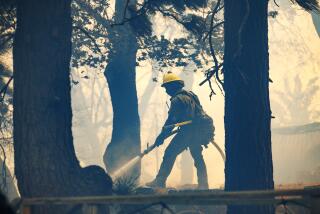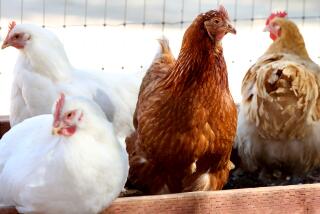Colorado cattle ranchers dig out--again and again
GRANADA, COLO. — The snow curled up before the massive plow blade fitted to the front of one of John Duvall’s tractors.
The 58-year-old rancher clenched his jaw as the vehicle trembled and then stalled. He still had a hundred yards of snowed-in road to clear before he could haul hay to the starving herd of cattle clustered in a small clearing.
“This is [what] you put up with every day,” Duvall said. “You’re working your butt off and looking at your livelihood go down the drain.”
The snow Duvall spends 10 hours a day clearing began to fall before Christmas, and has continued since. Howling winds blow it back across previously plowed roads and highways, regularly choking off travel in this isolated stretch of the high Plains. Coupled with unusually low temperatures, the snow has created a slow-motion disaster in an area already reeling from drought and depopulation.
More than 8,000 head of cattle have died in Colorado. Those that have survived are losing weight, their pastures buried under 2 feet of snow. Calves are dying within hours of birth, if they’re not stillborn. Equipment is wearing down, and local governments are burning through their budgets just trying to keep roads open.
“It’s almost like this is the straw that could break the camel’s back,” said Chad Hart, a representative for the U.S. Department of Agriculture here. “It’s affected the city, county and ranchers. It’s been ... tough.”
So far, there has been little federal help. The area was declared a disaster last month, but the Federal Emergency Management Agency will only reimburse local governments for 48 hours’ worth of expenses -- and many are racking up costs every day. “Probably more than half our [weather-related] expenses are going to be incurred from today on,” Gene Millbrand, a Prowers County commissioner, said this week.
Colorado Gov. Bill Ritter is asking the USDA to free up low-interest loans for ranchers. But state Agriculture Commissioner John Stulp, who owns a ranch in Prowers County, said that was expected to be a tough sell because so many other regions -- including California’s citrus belt -- also were seeking disaster aid after an arctic storm swept across the country this month.
Stulp said he feared the worst was yet to come. “This has been so enormous, it’s beyond what a typical winter would be,” he said. “And we’re only one month into it, with two more to go.”
Southeastern Colorado is used to hard times. Prowers County, which includes the hamlet of Granada, has lost 4% of its population since 2000, as young people leave for urban areas. A lingering drought has cut into crop yields and has led many ranchers to slim down their cattle herds. Last year, a bus manufacturer left the biggest town in the area, Lamar, taking 400 precious jobs with it.
“That’s why nobody lives out here,” said Ronnie Brown, 52, who owns Granada Feeders, a local feedlot. “Only the tough stay.”
Even the toughest are cutting their losses. Bobby Lord, who 20 years ago moved his cattle ranch from Nebraska to near Granada, sold his entire herd of 400 last week -- even though he hadn’t lost a single cow.
“All I wanted to do is get ‘em out of here,” said Lord, 61. He had plowed an area where the cattle could eat, but “you put a couple of hundred cattle on an area the size of a football field, and it’s going to get pretty messy. They just weren’t happy cows.”
Keeping cattle right now is a gamble. The deaths aren’t the biggest problem -- it’s the weight loss. Some estimate that each cow has lost about $100 in value so far. “You’ve got 400, 500 head, and you lose $100 a head, that’s a pretty good hit,” Brown said.
This is historically the warmest part of the state, with annual precipitation of 15 inches, the same as in Los Angeles. The climate makes it a prime place to raise cattle, which usually can graze through the year or stay in the numerous feedlots, untroubled by extreme weather.
This winter has been different. As much as 4 feet of snow has fallen since the first storm hit Dec. 20. Winds up to 60 mph created 16-foot-high snowdrifts, and temperatures have stayed below freezing almost all month. “We pretty much developed an actual glacier out there,” said meteorologist Bill Fortune of the National Weather Service station in Pueblo, Colo.
Though the vast majority of the snow fell toward the end of December, folks here say every day feels like a new blizzard. Jim Rogers, his wife and their two children left their ranch outside the town of Eads on Sunday to go to church and run errands -- normally a 20-minute drive. It took them six hours to get back home -- something they could only do because a neighbor lent the Rogers his tractor to plow the road to their ranch, which was covered by blowing snow.
Rogers hasn’t lost any cattle, but he worries that he’ll run out of feed soon. Like most ranchers, he was counting on the cows grazing on grass. The feed shortage has gotten so severe that the Colorado Cattlemen’s Assn. has started an online “hay list” to connect ranchers with suppliers.
Duvall thinks he’ll get through the winter, but it’ll take what he had believed was a two-year reserve of hay. He’s lost about 50 of the few thousand head of cattle he keeps on his ranch south of Granada. Every cluster of cows he passed on a recent tractor ride around his property included a couple of corpses. There was nothing to do but leave them on the icy ground.
What was once a landscape of rolling hills and ridges now is uniformly white and flat. The rural county roads are lined with 10-foot-high walls of plowed snow. One resident compares them to bobsled runs.
Duvall guesses he’ll need half to three-quarters of the money he makes from selling calves to pay for the snow damage. He might recoup some losses from improved crop yields once the snow melts, but the disaster will still eat into his savings.
“I don’t know of very many people,” Duvall said, “who ain’t going to have to borrow some money.”
More to Read
Sign up for Essential California
The most important California stories and recommendations in your inbox every morning.
You may occasionally receive promotional content from the Los Angeles Times.










